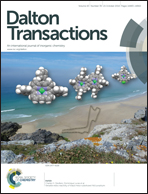Modulating the magnetic properties by structural modification in a family of Co-Ln (Ln = Gd, Dy) molecular aggregates†‡
Abstract
Two types of heterometallic aggregates of the general formula [(CoII)3(CoIII)2Ln3(μ3-OH)5(O2CtBu)12(L)2]·2H2O (Ln = GdIII (1), DyIII (2)) and [(CoIII)3Ln3(μ3-OH)4(O2CtBu)6(L)3](NO3)2·2CH3CN·2H2O (Ln = GdIII (3), DyIII (4)) were successfully isolated in reactions with [Co2(μ-OH2)(O2CtBu)4]·(HO2CtBu)4, Ln(NO3)3 and n-N-butyldiethanolamine (H2L) under ambient conditions by a change in the stoichiometry of the reactants from 1 : 1 : 1 to 1 : 1 : 2 in order. Bond Valence Sum (BVS) calculations and bond lengths indicate the presence of mixed valent Co (CoII, CoIII) centres in compounds 1 and 2 and only CoIII centres in 3 and 4 as required for the charge balances and supported by the magnetic measurements. Isostructural crab shaped complexes 1 and 2 feature distorted cubane cores that edge share to each other whereas the metallic core of 3 or 4 displays hemicubane like arrangement of metal centres and oxygen atoms. Overall structural symmetry was found to enhance on moving from the former to the latter series of complexes. Magnetic studies reveal significant magnetic entropy changes for complexes 1 and 3 (−ΔSm = 21.57 and 19.39 J kg−1 K−1) and single molecular magnetic behaviour for 2 and 4.


 Please wait while we load your content...
Please wait while we load your content...